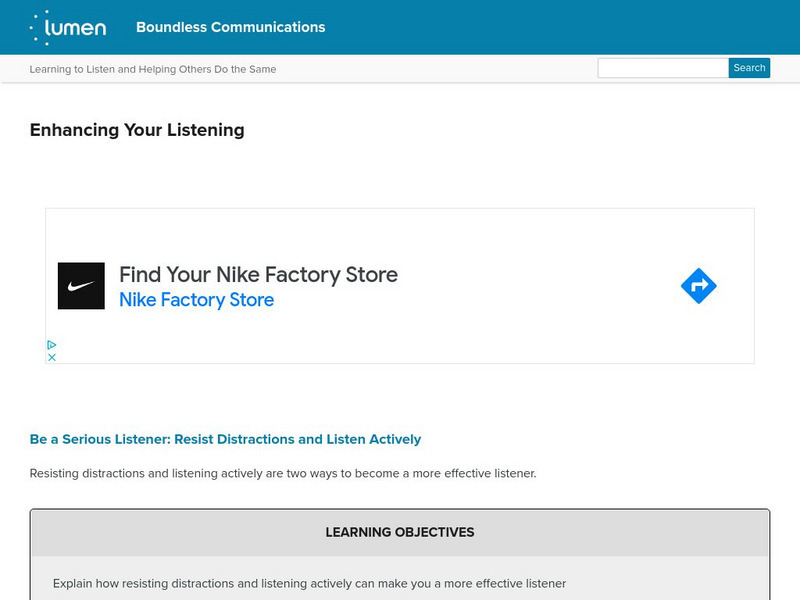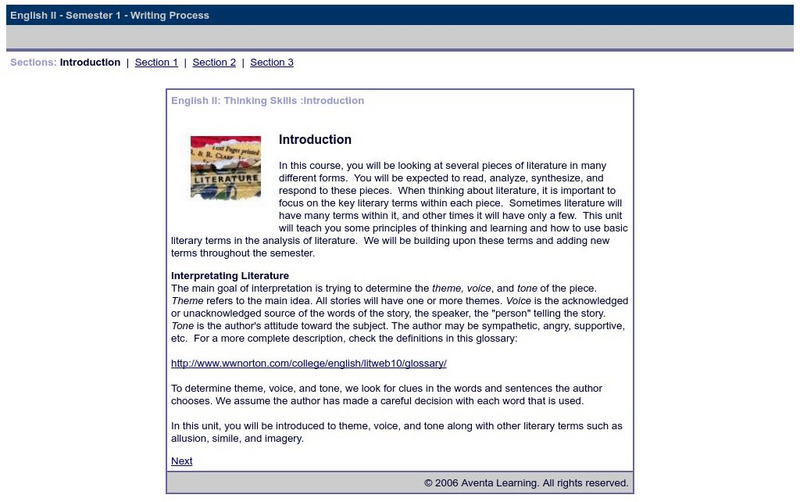Lumen Learning
Lumen: Analysis: The Language of Analytic Assignments
This lesson plan focuses on understanding the language of assignments that indicate the need or analysis including a list of verbs that denote the need for analysis and assignments that ask you how the parts relate to the whole, how...
Lumen Learning
Lumen: Writing Skills: Tone, Language, and Appeal
This lesson focuses on using tone, language, and appeal to recognize and evaluate rhetorical approaches to building common ground. RI.9-10.4 word meanings/impact of choice
Lumen Learning
Lumen: Boundless Communications: Enhancing Your Listening
In this Boundless Communication learners will learn the importance of being an active listener who can resist distractions and keep an open mind while suspending judgment and exercising empathy. SL.9-10.3 Eval Presentation, SL.9-10.3...
Get It Write
Get It Write: Cyberlanguage
Find out what various style manuals recommend in the way cyberlanguage is written.
CommonLit
Common Lit: Walking for My Life
CommonLit.org is a wonderful resource to use in a Language Arts classroom. Each story or article is accompanied by guided reading questions, assessment questions, and discussion questions. In addition, students can click on words to see...
CommonLit
Common Lit: Blizzard
CommonLit.org is a wonderful resource to use in a Language Arts classroom. Each story, poem, or article is accompanied by guided reading questions, assessment questions, and discussion questions. In addition, students can click on words...
CommonLit
Common Lit: Egg
CommonLit.org is a wonderful resource to use in a Language Arts classroom. Each story, article or poem is accompanied by guided reading questions, assessment questions, and discussion questions. In addition, students can click on words...
Department of Defense
Do Dea: Thinking Skills
In this self-guided course, you will be looking at several pieces of literature in many different forms. This unit will teach you some principles of thinking and learning and how to use basic literary terms in the analysis of literature....
Better Lesson
Better Lesson: L.3.5a: Distinguish Literal and Nonliteral Meanings of Words
Links to 18 lessons and activities that build student skills in standard L.3.5a: Distinguish the literal and nonliteral meanings of words and phrases in context (e.g., take steps).
Better Lesson
Better Lesson: L.3.2a: Choose Words and Phrases for Effect
Links to 4 lessons and activities that build student skills in standard L.3.3a: Choose words and phrases for effect.
Better Lesson
Better Lesson: W.4.2d: Use Precise Language and Vocabulary
Links to 27 lessons and activities that build student skills in standard W.4.2d: Use precise language and domain specific vocabulary to inform about or explain the topic.
Better Lesson
Better Lesson: W.4.9a: Apply Grade 4 Reading Standards to Literature
Links to 8 lessons and activities that build student skills in standard W.4.9a: Apply grade 4 reading standards to literature (e.g., Describe in depth a character, setting, or event in a story or drama, drawing on specific details in the...
Texas Education Agency
Texas Gateway: Literary Text: Diction and Tone
This lesson deals primarily with diction and tone and how to recognize them in your reading. Tone is largely determined by diction or the word choices a writer makes. The process of choosing the right word involves denotation and...
Alabama Learning Exchange
Alex: Literary Elements in Literature
This lesson is applicable to any story or novel in literature. The students will be introduced to twelve literary elements through a podcast. They will then be divided into small groups to complete activities involving story and literary...
Alabama Learning Exchange
Alex: Do You Know How?
Students will write in a technical genre. "Technical writing conveys specific information about a technical subject to a specific audience for a specific purpose. The words and graphics of technical writing are meant to be practical:...
South Carolina Educational Television
Know It All: Using Figurative Language to Shape Meaning and Style
The students will be able to identify different types of figurative language in a story and explain how the author uses figurative language to shape the meaning and style of the story.
South Carolina Educational Television
Know It All: Imagine Imagery
Third graders will dive into the word "imagery," learning what it means and using what they learn to describe a color using all 5 senses.
Louisiana Department of Education
Louisiana Doe: Curriculum Hub: Ela Guidebooks: Teenage Brain: Analyze Sentence Structure
Analyze the structure of a sentence from "Concussions Affect Teens More Than Kids and Adults, Study Says" to understand how the sentence is constructed and then create our own sentences that use a similar structure.
Grammar Tips
Who, That, Which
Need a quick reference for when to use who, that or which? This article offers a concise explanation.
Ted Nellen
Cyber English (By Ted Nellen): Imagery
This is a glossary entry that defines the term "Imagery."
Other
Polynesian University: Academic Writer: Analogy
Describes different writing strategies to be used with analogies to help get a point across. Gives three good examples.
Other
Grinnell College: The Function of Word Order and Parallel Structure
A fairly simple demonstration of the importance of word order in English sentences, with several examples. Also, a brief explanation of parallel structure, with examples. L.11-12.3 Language Functions/Style
Quia
Quia: Character Terms
Complete each sentence by typing the correct character word into each box in this ten-question quiz.
University of Victoria (Canada)
The U Vic Writer's Guide: Literary Term: Bombast
This site from The UVic Writer's Guide provides an excellent description of bombast language. Content includes a literary example.

















